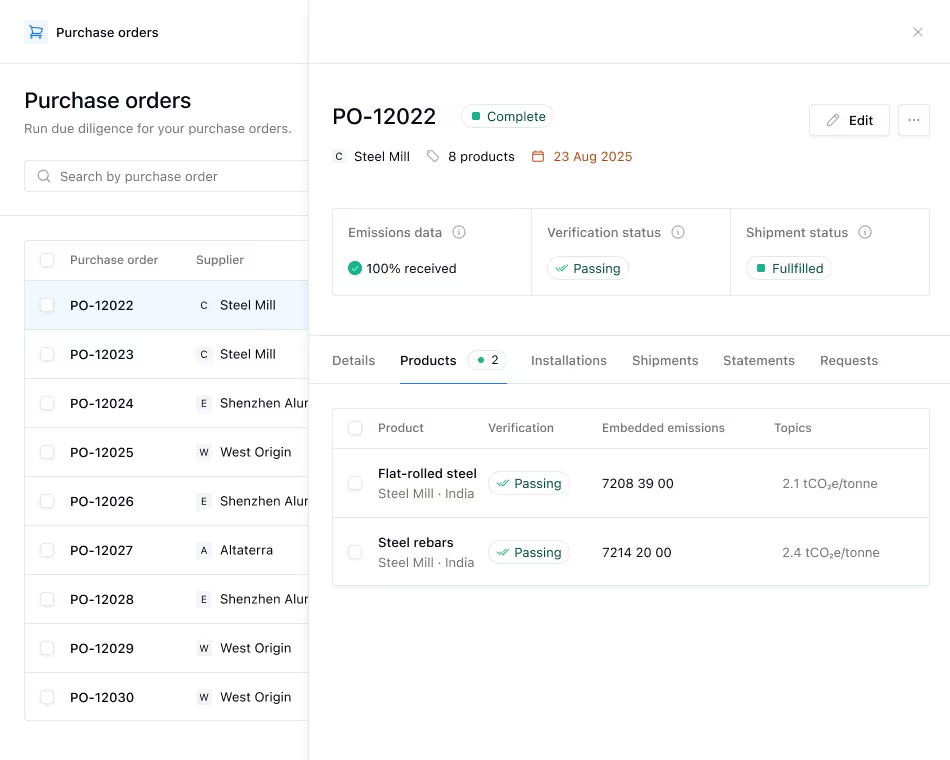Disclaimer: New EUDR developments - December 2025
In November 2025, the European Parliament and Council backed key changes to the EU Deforestation Regulation (EUDR), including a 12‑month enforcement delay and simplified obligations based on company size and supply chain role.
Key changes proposed:
These updates are not yet legally binding. A final text will be confirmed through trilogue negotiations and formal publication in the EU’s Official Journal. Until then, the current EUDR regulation and deadlines remain in force.
We continue to monitor developments and will update all guidance as the final law is adopted.
Disclaimer: 2026 Omnibus changes to CSRD and ESRS
In December 2025, the European Parliament approved the Omnibus I package, introducing changes to CSRD scope, timelines and related reporting requirements.
As a result, parts of this article may no longer fully reflect the latest regulatory position. We are currently reviewing and updating our CSRD and ESRS content to align with the new rules.
Key changes include:
We continue to monitor regulatory developments closely and will update this article as further guidance and implementation details are confirmed.
As the EU’s Carbon Border Adjustment Mechanism (CBAM) enters its definitive phase, imports from January 2026 onwards create CBAM certificate cost exposure. This means importers need to go beyond just tracking emissions and start understanding the financial implications.
This article walks you through how CBAM costs are calculated, using the official formula and real product examples. You’ll learn what data is required, including CN codes, embedded emissions, and the EU European Trading System (ETS) carbon price, and how to model likely costs across different scenarios.
To make it even more practical, the article also includes an interactive CBAM cost calculator. You can use it alongside the examples to estimate your own CBAM cost exposure and see how factors like volumes, origin, and emissions data influence the outcome.
Your CBAM costs depend on the embedded emissions in your imported goods. That is, the CO₂e generated during the production of these products. This quantity is then multiplied by the weekly average price of EU Emissions Trading System (EU ETS) allowances, as published by the European Commission.
Here’s a simple formula to remember:
CBAM cost = quantity (metric tonnes) × embedded emissions (CO2e / metric tonnes) × weekly EU ETS price
Importers should use emissions data collected to estimate and budget their certificate cost exposure for 2026 imports and beyond.
{{custom-cta}}
CBAM has been rolled out in two key stages: the transitional (reporting only) phase and the definitive (certificate purchasing) phase. As of 1 January 1, 2026 CBAM hasentered the definitive phase.
Importers were required to track and report the embedded emissions in CBAM-covered goods they bring into the EU. That meant submitting quarterly reports that include the quantity of goods and the CO₂e emissions linked to their production.
No certificate purchases were required.
Now, importers must purchase and surrender CBAM certificates to cover the embedded emissions in their imports. The cost of these certificates is based on the weekly EU ETS carbon price, making CBAM a real financial obligation, not just a reporting exercise.
Reporting moves from quarterly to annual, with the first full-year report due by 30 September 2027. Verified emissions data is required, in line with the EU’s CBAM methodology. And the use of default values is restricted. For complex goods, defaults can only account for up to 20% of total reported emissions.
{{cbam-calculator-injectable}}
To accurately estimate your CBAM costs, you’ll need to gather some key data points for each type of imported good.
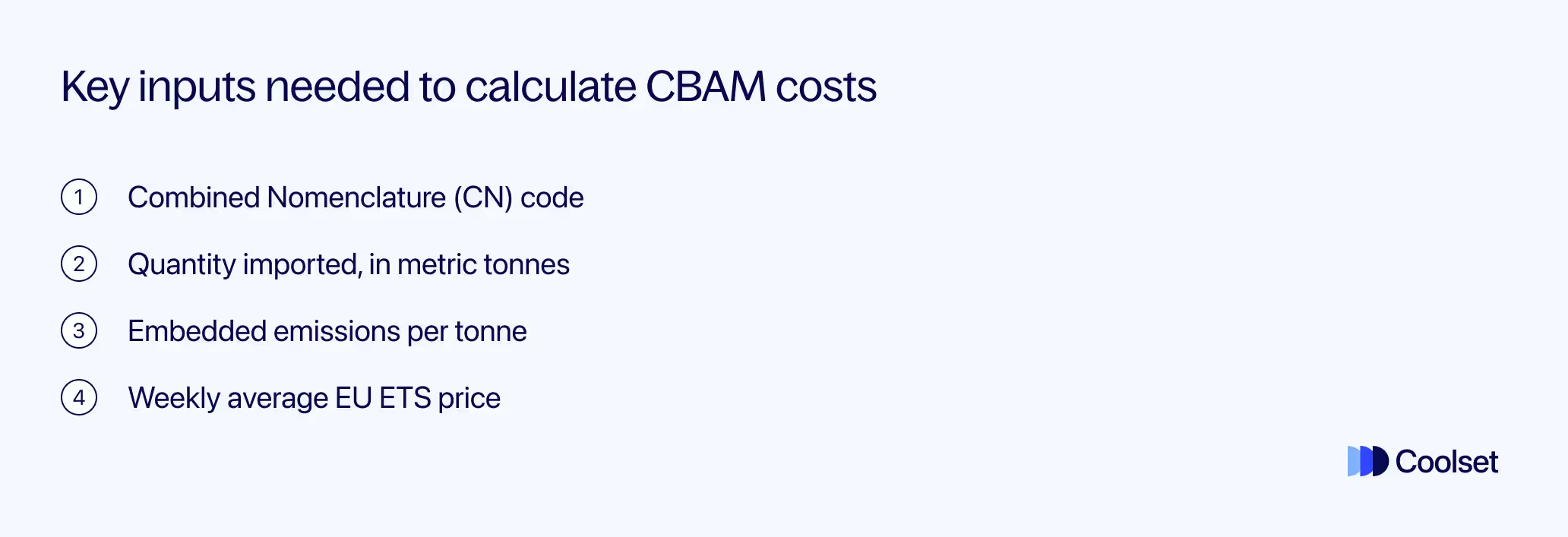
These include:
The Combined Nomenclature (CN) code of the imported product which helps you figure out whether it falls under the scope of CBAM.
The amount of each CBAM-regulated product, measured in metric tonnes, per specific CN code.
The amount of greenhouse gases released during the production of a product, measured per tonne of that product. This must be based on verified data from your supplier.
The weekly average EU ETS allowance price, published by the European Commission in the CBAM Transitional Registry.
For example, as of December 2025, the average price was approximately €83.90 per tonne of CO₂e. If you were importing goods with 1,000 tonnes of embedded CO₂ emissions, your CBAM certificate cost would be around €83,900 at that price point.
In 2026, default values still exist but they work like a penalty for missing data. They use conservative assumptions and can overstate embedded emissions, which increases the number of CBAM certificates linked to your imports.
Supplier-specific emissions data gives importers a cleaner path. It reflects how the product actually gets made at the producing installation and supports more accurate cost forecasting. If a supplier cannot provide usable data, treat that as a procurement and risk issue – not a reporting shortcut.
In the definitive phase, only direct emissions must be declared for certain types of iron and steel, aluminium, and hydrogen, while importers of cement and fertilisers will need to report both direct and indirect emissions. The CN codes that you do not need to report indirect emissions for can be found in Annex II of the CBAM regulation.
Based on the CBAM cost formula (CBAM cost = quantity × emissions per tonne × EU ETS price) let’s walk through a simple example using CN code 7307 11, which covers tube or pipe fittings of non-malleable cast iron.
Example calculation
CBAM cost = 100 × 2.3 × 80 = €18,400
This is the estimated cost the importer would face in the definitive (payment) phase for this shipment.
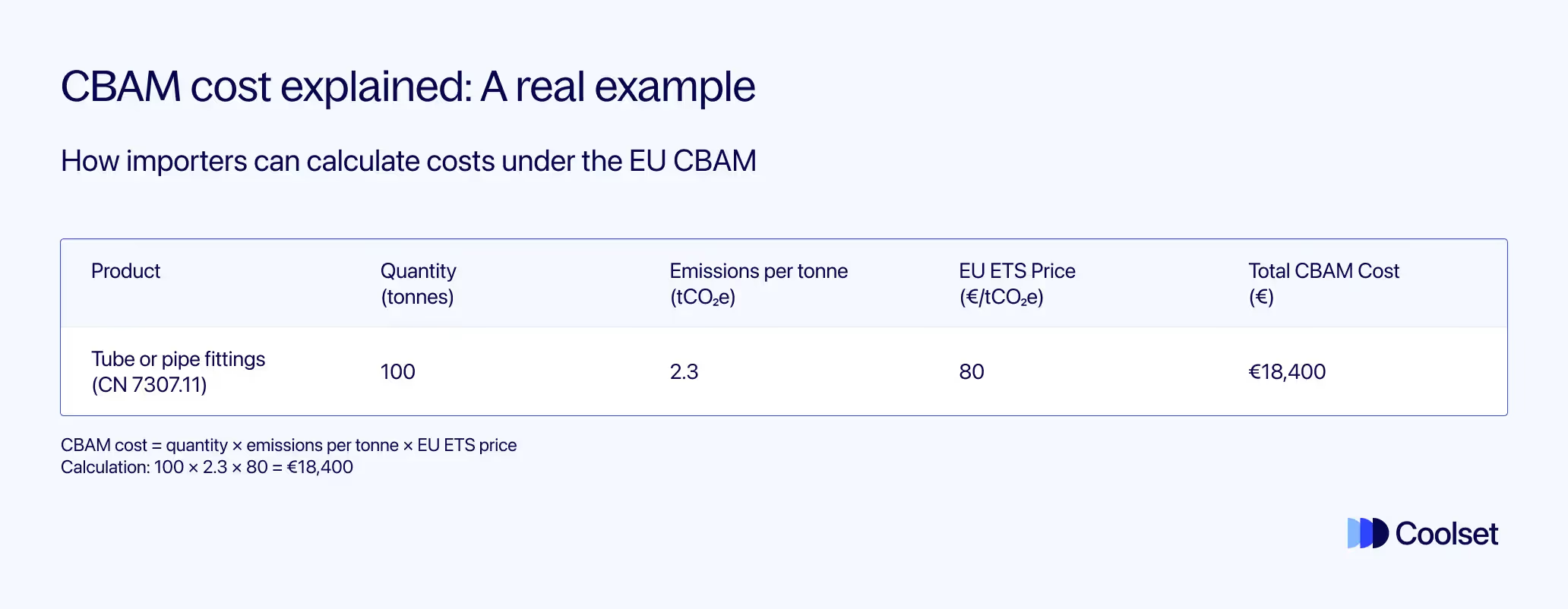
The European Commission’s default value for tube or pipe fittings of non-malleable cast iron is higher than actual supplier emissions. In this case, the default value is 3.11 tCO₂e per tonne, meaning the same shipment would cost:
CBAM cost = 100 × 3.11 × 80 = €24,880
That’s a €6,480 increase, just from using default data.
In 2026, default values should be treated as a last resort, as they can materially inflate reported emissions and increase the number of CBAM certificates you need to surrender.
CBAM is now in its definitive phase and 2026 imports create certificate cost exposure. Importers who forecast early can budget with confidence, spot high-cost products and suppliers, and avoid surprises when certificates must be surrendered.
Here’s how to get started:
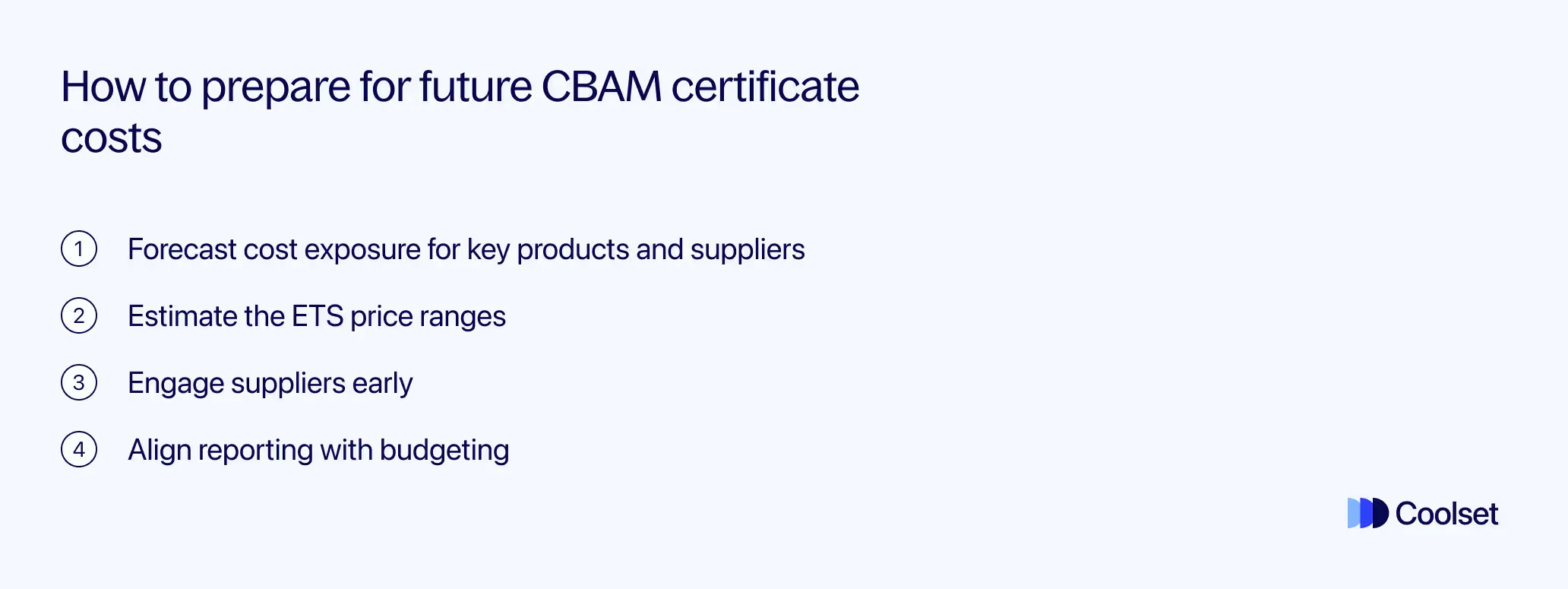
Focus first on high-volume or high-emission goods, and suppliers in countries without strong carbon pricing. Use the CBAM cost formula to model different scenarios and identify where your biggest liabilities may sit.
The EU ETS carbon price fluctuates. For planning purposes, assume a price range of €70–100 per tonne of CO₂e. Build your forecasts using both conservative and worst-case pricing to understand your potential exposure.
Request verified emissions data from your suppliers now, especially for complex goods. This step directly impacts your future CBAM costs, as embedded emissions (both direct and indirect) are a core input in the cost calculation formula.
Now is the time to engage suppliers to calculate or verify emissions in line with EU requirements.
Use your quarterly CBAM reports generated in the transitional year as the basis for internal forecasting and financial planning. As of 1 January, 2026, these reports are the trigger for CBAM certificate purchases, so aligning now helps streamline budgeting later.
Spreadsheets can get you started, but they won’t take you far. As reporting requirements grow more complex, manual tracking across multiple CN codes, products, and suppliers becomes time-consuming, error-prone, and nearly impossible to scale.
That’s where purpose-built tools come in.
Emerging platforms, like Coolset, are building solutions to help importers:
While the ecosystem is still in its early stages, adopting the right tool early can save hours of work, and prevent costly mistakes down the line.
Let’s walk through some frequently asked questions about CBAM cost calculations and CBAM certificate prices.
Use this formula: CBAM cost = quantity (in metric tonnes) × embedded emissions per tonne × weekly EU ETS price. You’ll need forecasto run this calculation for each CBAM-covered good you import.
For example, let’s say you’re importing 500 tonnes of unwrought aluminium (CN code 7601). Assume your supplier provides verified emissions data showing embedded emissions of 4.9 tCO₂e per tonne. If the average weekly EU ETS price is €75 per tonne, then your CBAM cost would be: 500 × 4.9 × 75 = €183,750.
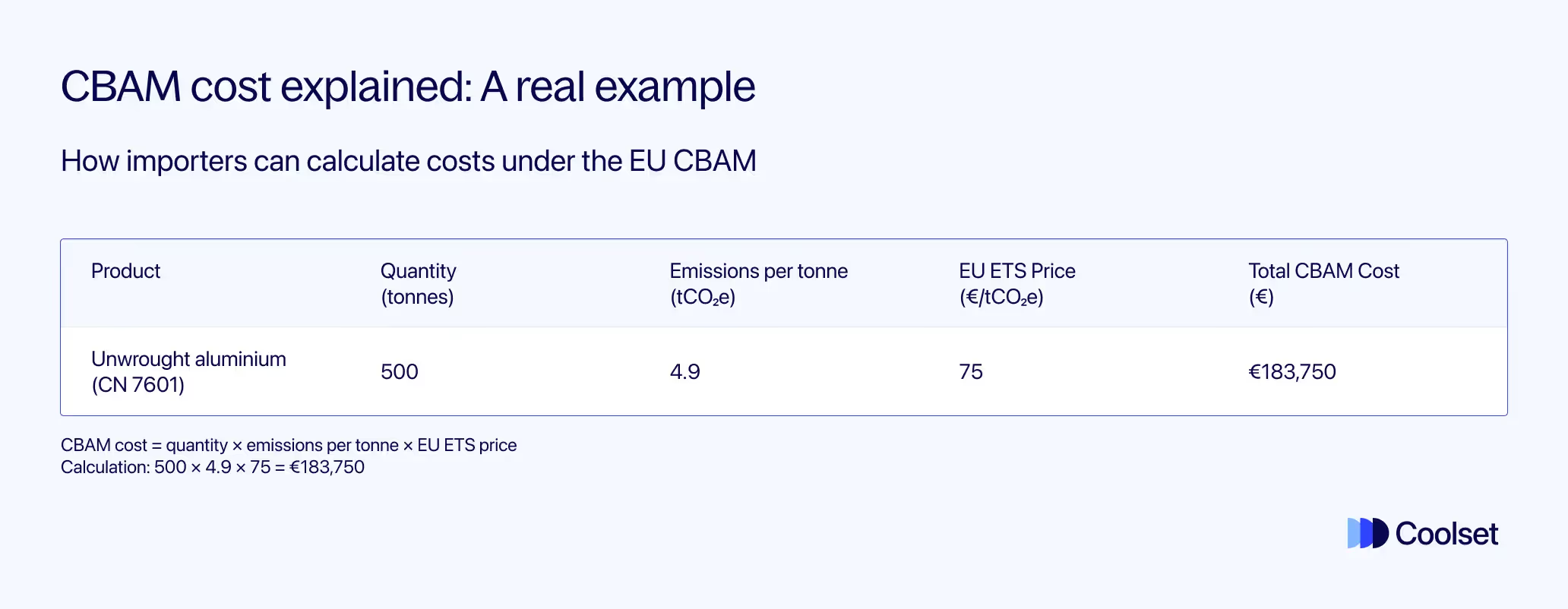
You’ll need:
CBAM certificate costs apply to imports from January 2026 onwards. Importers must surrender certificates covering 2026 imports with their first annual CBAM declaration, due in 2027. Reporting is now annual, not quarterly, and emissions data directly determines certificate exposure.
Under CBAM rules, using verified emissions data from your suppliers instead of EU defaults is the standard.
EU default values are conservative and should only be used as a last resort. Relying on supplier data helps avoid overstated emissions and unnecessary certificate costs.
The European Commission provides a CBAM Communication Template for Installations to calculate CBAM costs, but it’s a complex spreadsheet, useful for initial reporting, but difficult to scale across multiple products, suppliers, and CN codes.
Platforms like Coolset are now developing more advanced tools to automate calculations, map emissions data, and simulate future CBAM costs, all in one place.
With the definitive (payment) phase already here, now is the time to forecast your CBAM cost exposure, starting with the products and suppliers likely to carry the highest emissions. The more accurate your data now, the more confident your cost estimates will be later.
Coolset helps importers streamline emissions tracking, engage suppliers, and stay compliant, without the hassle. Reach out today to learn more.
Related articles:
Find out where EU default values inflate CBAM exposure and what it takes in practice to replace them with supplier-specific data
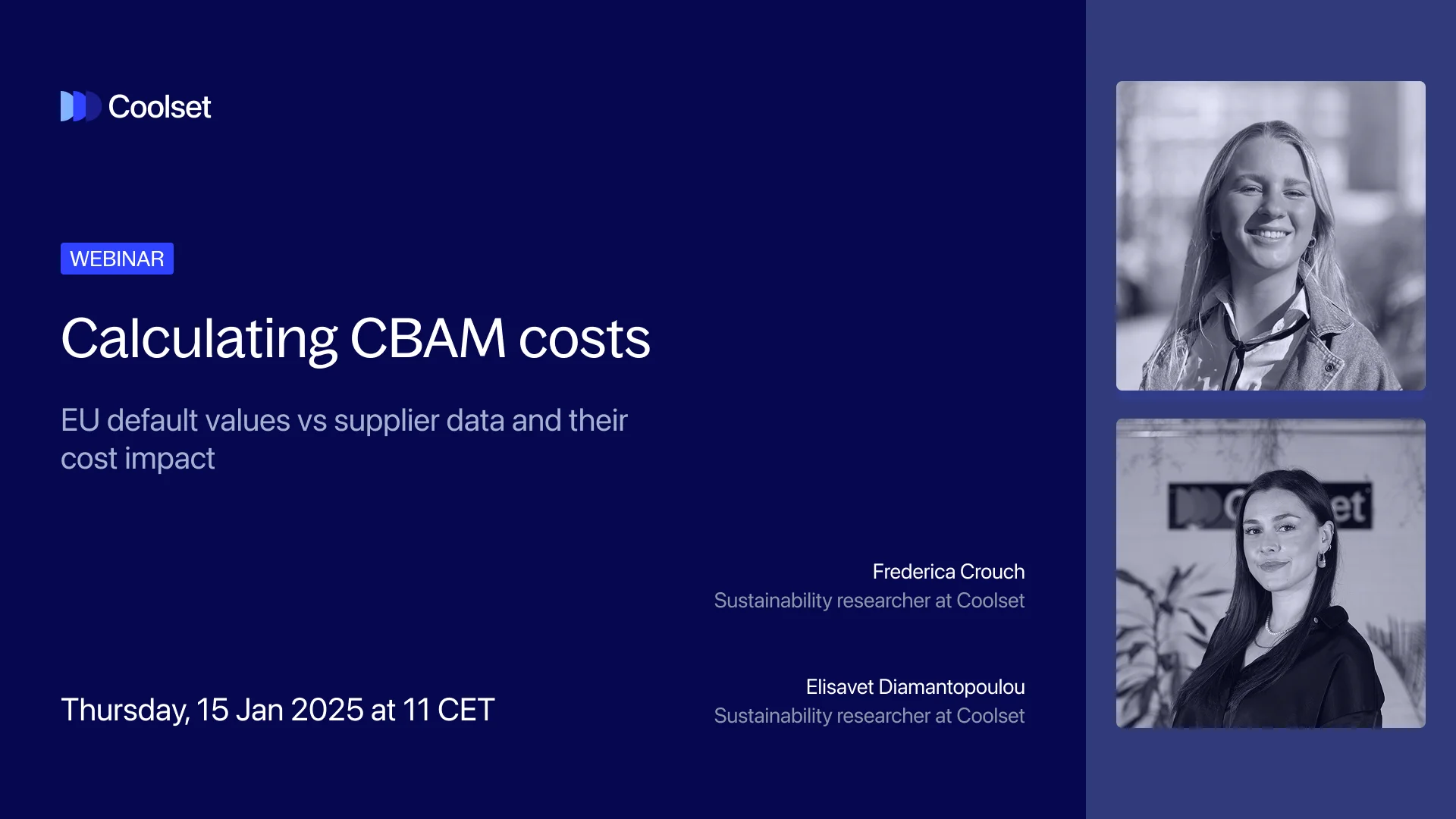
Map your imports, collect emission data from suppliers and calculate total volumes in one intuitive platform.
